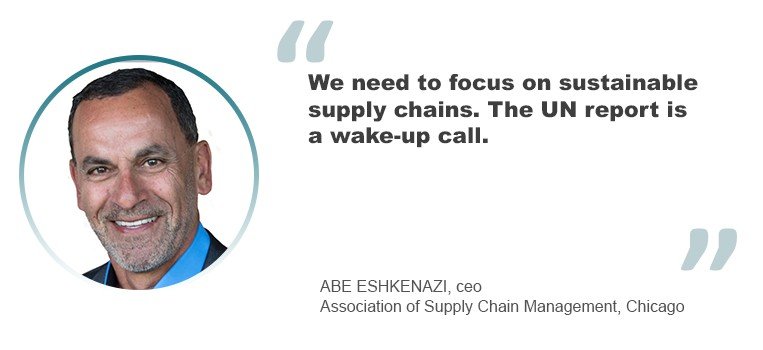Supply chains are facing an escalating risk of disruptions from severe weather conditions, with massive financial repercussions. Analysts and industry executives warn that shippers and logistics providers have to step up their risk management and take steps to minimize potential damage.
Supply chains have buckled under severe stress during the past two years through a combination of disruption (like factory closures and lockdown measures) and a deluge of traffic that has overwhelmed logistics infrastructure. The financial fallout is severe. Fashion retailer Gap lowered its full-year forecast in November in anticipation of a US$650 million hit on revenues due to factory closures in Vietnam and other supply chain disruptions and the need to shift goods to air freight.
These impacts will pale in comparison to the repercussions of severe weather, experts warn. The report on climate change released earlier this year by the United Nation’s Intergovernmental Panel on Climate Change, which was based on over 14,000 scientific studies, concluded that the effects of this development – like extreme droughts, severe heat and catastrophic downpours and flooding – will continue to worsen for at least the next 30 years.
Agriculture stands to be one of the most affected sectors. This year a record drought drove up the price of Brazilian coffee by 60%, and a heat wave dented the cherry crop in the U.S. Pacific Northwest by about 20% from predictions in May. Lumber and Christmas trees have been in short supply in North America in part because of wildfires.
“We need to focus on sustainable supply chains. The UN report is a wake-up call,” said Abe Eshkenazi, CEO of the Association of Supply Chain Management in Chicago.

Experts have noted, though, that no sector is immune. A recent report from the United Nations Development Program estimates that workplace disruptions caused by climate change could result in more than US$2 trillion in productivity losses by 2030.
Torrential rains that hit British Columbia in November severed highway and rail links between Vancouver and the Canadian interior, paralyzing cargo flows to and from the nation’s largest gateway. Links were restored after a week, but services have been running at diminished capacity, and operators estimate it will take a while for capacity to return to normal levels. The movements of outsize cargo remains heavily constrained until all repairs to the infrastructure are completed, one operator said.
It was the second disruption of rail service between Vancouver and the Canadian interior in 2021. In the summer excessive heat led to wildfires that caused damage to rail tracks in a canyon, forcing the railroads to suspend service.
In early December, cargo insurance specialist TT Club presented findings of its analysis of claims over the last three years pertaining to weather-related risk. Inland operations suffered damage caused by extreme weather in 32% of cases, nearly half the percentage (68%) of cases in locations near a coast, with 16% of claims involving flooding from heavy rainfall. Property damage through strong winds and microbursts featured in 74% of weather-related claims through the period.
Unrelated to climate, human supply chain disruptions are also rising, according to a report by Resilinc, a supply chain risk monitoring specialist. Factory fires have been up 150%, which the authors attribute to a combination of gaps in regulations and process execution and a shortage of skilled labour.
Many firms have to step up their risk analysis of their supply chains. According to a recent study by consultancy McKinsey & Company, this is an area where companies have been less willing to invest in than other technologies to monitor and manage supply chains. David Shillingford, CEO of Everstream Analytics, a supply chain risk management provider, called risk analysis a cornerstone of a flexible and secure supply chain.
This should include predictive analytics to identify disruptions before they occur. “If you know in advance that there is going to be a problem, that makes a huge difference,” he said.
TT Club notes that the capability to monitor and predict weather patterns will continue to develop. “This understanding will not physically protect property, equipment and operations but, when utilized as an integral component of thorough risk assessment, it should inform operational decision-making,” the insurer stated.
A key step in this direction is an effort to digitize supply chains as much as possible. “You need to digitize your supply chain for visibility,” stressed Keith Woods, global supply chain director of Coca-Cola.
With the right tools in place, companies can run a risk-adjusted supply chain, which is as lean as can be while dynamically taking risk into account, Shillingford said, describing such a set-up as being both just-in-time and just-in-case.
TT Club points out that in the event of a disruption like flooding, proper packaging of cargo can make a massive difference. It found that 65 percent of cargo damage incidents were attributable in part to the way that goods are packed within a container or cargo transport unit. Data for 2020 suggests that 25% of wet cargo damage was caused by water ingress into the unit through pre-existing damage that should have been identified in the packing process.
“Many claims therefore can be avoided with a robust pre-loading condition checking procedure and correct packing processes,” TT Club advises.
Ian Putzger



